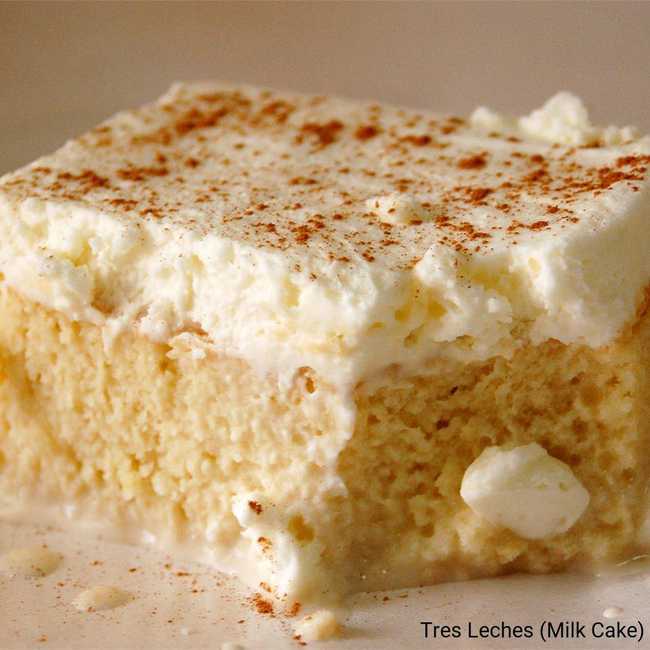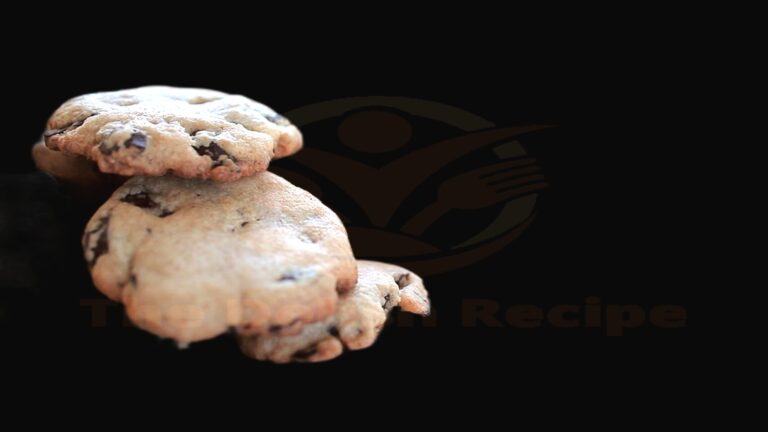Tres Leches (Milk Cake)
This recipe is for a traditional Mexican dessert called Tres Leches (Milk Cake). It is a sponge cake soaked in a mixture of three kinds of milk, topped with whipped cream and flavored with vanilla. This cake is very popular in Latin American countries and is often served at celebrations such as weddings and baptisms.
Ingredients
- 1 ½ cups all-purpose flour
- 1 teaspoon baking powder
- ½ cup unsalted butter, softened
- 1 cup sugar
- 5 eggs
- ½ teaspoon vanilla extract
- 2 cups whole milk
- 1 (14 ounce) can sweetened condensed milk
- 1 (12 fluid ounce) can evaporated milk
- For the topping:
- 1 ½ cups heavy whipping cream
- 1 cup sugar
- 1 teaspoon vanilla extract
Instructions
1. Preheat your oven to 350 degrees Fahrenheit (175 degrees Celsius). Grease and flour one 9×13-inch baking pan.
2. Sift the flour and baking powder together and set aside in a bowl.
3. Cream butter or margarine with 1 cup of sugar until fluffy. Add eggs and ½ teaspoon of vanilla extract; beat well until combined.
4. Add the flour mixture to the butter mixture 2 tablespoons at a time; mix until well blended before adding more flour mixture. Once all of the flour mixture has been added, pour batter into prepared pan from earlier step 1..
5 Combine whole milk, condensed milk, and evaporated milk together in a bowl or pitcher then pour over top of cooled cake from earlier step 3.. Whip whipping cream, remaining 1 cup of sugar, and remaining 1 teaspoon vanilla together until thick then spread over top of cake.. Be sure and keep cake refrigerated
Nutrition Facts
- Serving size: 1 slice
- Calories: 400
- Fat: 18 g
- Saturated fat: 11 g
- Unsaturated fat: 7 g
- Trans fat: 0 g
- Cholesterol: 100 mg
- Sodium: 170 mg
- Carbohydrates: 52 g
- Fiber: 1 g
- Sugar : 40 g Protein 8g

What language is Tres Leches?
Tres Leches is a Spanish language dessert cake. The name comes from the fact that the cake is made with three different kinds of milk: evaporated milk, condensed milk, and whole milk.
The exact origins of Tres Leches are unknown, but it is thought to have originated in Latin America, specifically in Mexico or Nicaragua. The first recorded recipe for Tres Leches was in an Argentine cookbook from 1953. However, it is likely that the cake was being made long before this time.
Tres leches means “three milks” in Spanish, and as such, this cake is very moist and rich. It’s traditionally served with a dollop of whipped cream on top, and sometimes also garnished with fresh fruit like strawberries or raspberries.
What country is tres leches cake from?
Tres leches cake is a traditional Latin American dessert that has become popular in many parts of the world. The name “tres leches” means “three milks”, and refers to the three types of milk used in the cake: evaporated milk, condensed milk, and whole milk.
There are many different recipes for tres leches cake, but they all typically involve sponge or pound cake soaked in themilk mixture, topped with whipped cream or meringue, and then refrigerated until firm.
The origin of tres leches cake is uncertain, but it is thought to be from Central America or Mexico. One theory is that it was created by European immigrants who adapted their own cakes using local ingredients. Another theory is that it originated with native people who had been making a similar dish called “pan de muerto” (“bread of the dead”) for centuries. Whichever story is true, there’s no doubt that tres leches cake is now firmly entrenched as a beloved part of Latin American culture.
Is tres leches cake Spanish or Mexican?
There are a few different origin stories for tres leches cake, but the most commonly accepted one is that the cake originated in Mexico. The name “tres leches” translates to “three milks”, which refers to the three types of milk used in the cake recipe: evaporated milk, condensed milk, and whole milk.
Tres leches cake is thought to have first appeared in print in a Mexican cookbook from 1905 called El Libro De Cocina Completo Para Damas Y Caballeros (The Complete Cookbook For Ladies And Gentlemen). The book contained a section on cakes and pastries, and included a recipe for tres leches cake. It’s believed that this was the first time the dessert was ever documented.
While there are many similar desserts throughout Latin America, tres leches cake has become synonymous with Mexico. This is likely due to its popularity within Mexico; you’ll find tres leechescake served at nearly every Mexican bakery, restaurant, and taquiera. Tres leeches cake has even become something of a national symbol for Mexico, appearing on everything from postcards to T-shirts.
So while there may be some debate over where exactly tres leches cake originated, it’s safe to say that it’s now firmly entrenched as a beloved Mexican dessert.
Why is tres leches cake so wet?
Tres leches cake is a type of sponge cake that is soaked in a mixture of three milks: evaporated milk, sweetened condensed milk, and whole milk. This gives the cake its signature moist and spongy texture.
The evaporated milk helps to thin out the heavy cream and sweetened condensed milk, while still providing a rich flavor. If you were to use just regular milk, the cake would be much soggier due to the higher water content.
So why is tres leches cake so wet? It’s because of the combination of three different types of milk! The evaporated milk helps to keep the cake moist and spongy, while also giving it a rich flavor.
How do you make Tres Leches less soggy?
There are a few things you can do to make your Tres Leches cake less soggy. First, make sure that you use whole eggs in the cake batter. This will create a sturdier cake that won’t deflate as easily when soaked in the milk mixture. Second, be careful not to oversoak the cake. You want it to be moist, but not too wet. Third, try using evaporated milk instead of regular milk for the soaking mixture. This will give the cake a richer flavor and help it hold up better under the liquid. Finally, don’t forget to serve the cake cold or at least chilled. This will help it maintain its structure and prevent it from becoming mushy.




